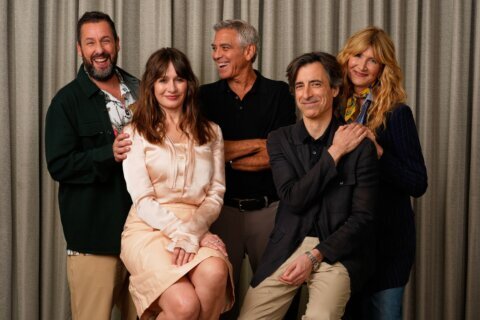WASHINGTON — There’s a fine line between profound and pretentious, and for much of his career, Terrence Malick has straddled it, creating transcendent work that defies plot conventions to explore mankind’s most existential themes.
“Badlands “(1973) was a gritty breakthrough, turning the Starkweather Homicides into a “Bonnie and Clyde” tale of young fugitive lovers that introduced the world to Martin Sheen and Sissy Spacek.
“Days of Heaven” (1978) was a moody masterpiece that launched Richard Gere in the glow of “magic hour” natural light, Biblical themes and Ennio Morricone’s haunting take on “Carnival of the Animals.”
“The Thin Red Line” (1998) marked a powerful return by the enigmatic filmmaker after 20 years in recluse, adapting James Jones’ autobiography about the Guadalcanal conflict during World War II.
And “The Tree of Life” (2011) won Cannes’ Palme d’Or by ambitiously juxtaposing intimate moments of 1950s suburbia with the entirety of evolution, from plasma formations to the birth of dinosaurs.
But while I’ve long been one of his most ardent defenders, I fear Malick has lost his way with “Knight of Cups,” giving into his worst impulses to create a work so indulgent that it borders on self-parody. Like its protagonist, the film wanders from place to place, image to image, without saying a thing.
The story (using that term loosely) follows a depressed Hollywood screenwriter (I think) named Rick (Christian Bale), who drifts between Los Angeles and Las Vegas, enjoying the neon pleasures of Caesars Palace, the palm trees of Venice Beach and the surf of the Pacific Ocean. Along the way, he recalls failed romances with six different women: Della (Imogen Poots), Isabel (Isabel Lucas), Nancy (Cate Blanchett), Helen (Freida Pinto), Karen (Teresa Palmer) and Elizabeth (Natalie Portman).
We won’t go any further into their characters because the script doesn’t bother either, parading the women on screen in flowing garb and as much discernible dialogue as random cameo appearances by the likes of Antonio Banderas, Ryan O’Neal and Jason Clarke during swanky Hollywood parties.
Throughout this drifter’s journey, we get a stunning sensory collection of fish-eye lenses, whispered voice-over narration and jarring close-ups, which worked beautifully as intimate memories of fireflies and baby steps in “The Tree of Life.” Once again, there’s ethereal music by Hanan Townshend and gorgeous cinematography by three-time Oscar winner Emmanuel Lubezki (“Gravity,” “Birdman,” “The Revenant”), who offers mesmerizing compositions of both the natural and man-made worlds.
But that’s where the film’s praises must stop, as Malick slips into that old Shakespeare trap of “sound and fury, signifying nothing.” We see glimpses of what might have made a fascinating character study, as Bale is haunted by his brother’s death — just like Sean Penn in “The Tree of Life” — clashing with his brother (Wes Bentley) and father (Brian Dennehy), who washes blood off his hands. Frustratingly, Bale remains impenetrable, roaming around virtually silent and revealing little about his demons.
Perhaps it was important for Malick to choose “The Dark Knight” as his “Knight of Cups,” just as Alejandro G. Inarritu cast Michael Keaton as “Birdman” to mock Hollywood’s superhero excesses.
Like Fellini’s warning in “La Dolce Vita” (1960), Malick’s overarching theme appears to be a critique of the hedonistic lifestyle, depicting the “emptiness” of Hollywood with vacant studio lots becoming deserted ghost towns. As Bale makes a handprint in the California sand, you’ll recall the cement handprints along Hollywood’s Walk of Fame, only for a wave to wash it all away, suggesting the impermanence of fame, as a narrator whispers about the clash of “light and dark,” tide in, tide out.
Many of these voice-over ramblings quote the Christian allegory “The Pilgrim’s Progress” (1678) and the “Hymn of the Pearl” from the “Acts of Thomas.” We’re told the fable of a young prince whose father sent him down into Egypt to find a pearl, but when the prince arrived, the people poured him a cup. Drinking it, he forgot he was the son of a king, forgot about the pearl and fell into a deep sleep.
This “Knight of Cups” is visually represented by a tarot card, which coincides with various chapter titles throughout the film: The Moon, The Hanged Man, The Hermit, The Tower, The High Priestess, Judgment, Death. But unlike Quentin Tarantino’s “The Bonnie Situation” in “Pulp Fiction” (1994) or “Minnie’s Haberdashery” in “The Hateful Eight” (2015), Malick’s chapter titles lack narrative juice.
When Agnes Varda used tarot cards in her French New Wave gem “Cleo from 5 to 7” (1962), she at least gave Cleo a ticking-clock concern of awaiting the results of a medical test to see if she has cancer. More recently, when Matthew Weiner used them in “The Mountain King” episode in Season 2 of “Mad Men” (2007-2015), Anna Draper gave Don a tarot reading to chart his character growth.
At first, Don dismissed the reading: “It’s an ink blot. You see what you want to see.” Anna pressed on: “You are part of the world. Air, water, every living thing is connected to you,” to which Don said, “It’s a nice thought. … What does it mean?” Anna replied, “It means the only thing keeping you from being happy is the belief that you are alone.” “What if that’s true?” “Then you can change.”
Despite countless womanizing relapses, Don Draper did in fact change by the series’ end. Bale’s character in “Knight of Cups” does not change at all. He drifts and drifts, as we viewers scratch our heads at his goal. At least in Fellini’s “8 1/2” (1963), we knew that Marcello Mastroianni’s filmmaker was trying to direct a movie masterpiece. Bale’s Rick could just as easily be a surfer as he is a screenwriter. That’s the ultimate irony — Malick appears to have lost all respect for screenwriting.
There was some semblance of a forward-moving plot in “Badlands,” but decades later in “Knight of Cups,” Malick has adopted a mindset that sheer imagery can replace the art of telling a story. He thinks theme can outweigh plot, not realizing that great movies require the proper balance of both.
If you want a commentary on the corrupt lifestyle of Los Angeles, give me a movie like “Chinatown” (1974), combining the artful directorial vision of Roman Polanski with the masterful script of Robert Towne. Even an L.A. period piece like Paul Thomas Anderson’s “There Will Be Blood” (2007) matched its gorgeous directorial concepts with a driving narrative arc for its anti-hero Daniel Plainview.
The two talents — writing and directing — should work in tandem, complementing each other to create something that neither could on its own. Look no further than Alfred Hitchcock or John Ford to see how cinema works wonders when the page and the camera both have something to offer.
Don’t get me wrong. I absolutely agree with Malick that too many mainstream movies are overly plotted without symbolic direction. But unlike Malick, I also firmly believe that the inverse extreme is just a dangerous, leaving us with arthouse films that avoid plot all together at their storytelling peril.
This review isn’t some treatise against the “artsy.” On the contrary; that ignorant tag is given by lazy viewers who shy away from anything that pushes the limits. We should want our movies to be “artsy,” to push the envelope, to think outside the box. We should crave a good auteur challenge, actively engaging with the material and constantly scanning the images for symbolic meaning and social commentary parallels. But, you’ve got to give us some sort of story skeleton to hang it upon.
Just as critics must call out a poorly-made commercial blockbuster if it doesn’t add anything artistically to the medium, we must also call out an art-house film that lacks any semblance of story.
That’s why, at the height of his “Godfather” and “Apocalypse Now” filmmaking prowess, Francis Ford Coppola brilliantly said: “Nothing is so terrible as a pretentious movie, a movie that aspires for something really terrific and doesn’t pull it off is sh*t, it’s scum, and everyone will walk on it as such.”
It’s time to walk on it as such. You could rearrange the scenes in “Knight of Cups,” walk in halfway through, or walk out halfway through, and you’d still leave with the same level of understanding.
In fact, at the preview screening, many of the seats became increasingly empty as critics bailed early. You’ll be tempted to do the same. When the end credits arrive — “Written and Directed by Terrence Malick” — you’ll cheer, not because of your affection, but because the experience is mercifully over.
Then, as you stagger down the street away from the movie theater, you’ll ponder the meaning of the titular tarot card. Facing up, it signifies someone who is a dreamer, a bringer of ideas, constantly bored and craving artistic stimulation. In many of his past films, Malick has used this approach to his advantage. But when the tarot card is reversed, it represents recklessness, fraud and false promises.
Behold, “Knight of Cups.” Its cup does not runneth over. It is not half full, nor is it half empty. It is entirely bare. As a different Knight told Indiana Jones’ doomed rival, “You have chosen, poorly.”








